Influences from the Poster Day Bill
I always cited the sources of my imagery or iconography derived from art history books, museums or archaeology to have derived from so-called high art both old and new masters. But re thinking was in order as some unconscious images came to the fore. Yesterday on eBay I scrolled through posters on display. They were arranged in chronological order ranging from recently dated reaching back to the 1950s. I found the change of style over time quite interesting as both ends of this spectrum showed how technology changed designs and their content.
Today it is possible to create tonally complex figurative imagery where a protagonist in a particular scene selected from the movie and situated in a complex perspective realist or hyper realist styled background constituted the poster format design. However many of these literal images selected as part of a narrative, often depicted using tenebrism, a darkened Caravaggio style enhancing the feeling of action, were often hard to read in an eye-grabbing instant compared to the designs of the 1950s. The shiny glossy surface was also a point of contrast placed next to the opaque day bills of the 50s.


Even though the latest imagery is detailed (regardless of content which is another story), realistic, atmospheric, tonal ( the figures have weight and volume ) and are placed in a fairly realistic perspective space, the visual impact came from first posters for me. Disregarding the subject matter, the formalist values, the flattened figure with hard edges and bright colour caught my attention immediately.
The text showed polished almost glowing 3-D lettering arching along the bottom line in contrast to the text in the early poster that is simple, flat probably done by hand or type set ( Letraset a few years away ? ) with no attempt at atmospheric perspective. However by placing secondary figures and other aspects of the narrative almost in miniature compared to the figure of the protagonist the sense of distance fell into place.
One type of dramatic action was about an adventure and the other was about a romance rendered with flat contrasting colour.
I wondered why these old style posters apart from the nostalgia they evoked of a by-gone era played on my mind. In that era without colour television my main sources of imagery from popular culture were these posters, the movies, comics and comic strips in newspapers, Time and Life magazines and The Saturday Evening Post (Norman Rockwell). I became aware a strong influence some of these posters had on the unconscious formatting of my imagery in a formalist sense.
For example the image from a mural titled Women of the Interior while being about a protagonist who explored the Australian Outback had a composition imprint related to the first image though the colour related to the desert.
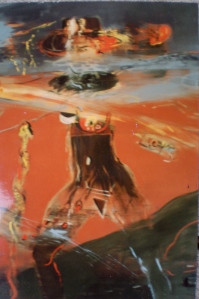
This image was also similar in that figures placed in the foreground had smaller images placed around the main figure positioned in a way to heighten the sense of drama. In the far distance, through the keyhole the artist engaged in the act of painting took second place to the foreground fantasy figures.

Influences from the classroom portrait
Another unexpected source of imagery derived from old master prints was The Laughing Cavalier by Frans Hals and Vincent Van Gogh self portraits that appeared to stare down from above a classroom mantle piece.
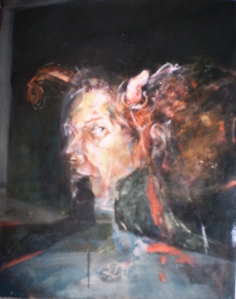
Influences from the school chapel
As well as the format of the 3/4 view classroom portrait the prints in the school chapel included The Last Supper by Leonardo da Vinci . The frontal portrayal of Christ was also a well used iconic image.
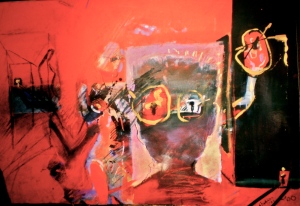
Placed beside the altar in which hung the da Vinci The Last Supper print was a framed print of The Annunciation by Fra Angelico.


This painting was about the relationship between artist and model. The model’s assertive behaviour reversed the usual procedure where the artist had control of the gaze.
Influences from the comic strip
My compositions some times constructed in triptych or diptych format hark back to an era of comics and comic strips. The topic may be complex and have embedded in the imagery reference to history, myth or allegory. By dividing the composition into segments the artist can suggest many dimensions and layered meaning to the viewer where each segment became part of the whole composition.

On the other hand an artist may want to portray several versions of a topic and paint a series of related images but each image can exist on its own.
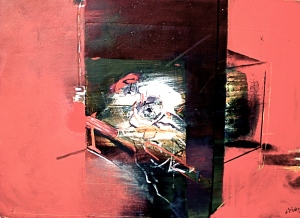


Although the comic strip derived images read horizontally I also enjoy suggesting to the viewer a sense of depth in parts of the composition that could be read as though looking through a window. I enjoy fusing together different ways of looking.
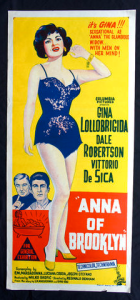
You must be logged in to post a comment.